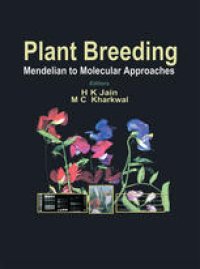
Ebook: Plant Breeding: Mendelian to Molecular Approaches
- Tags: Plant Sciences, Tree Biology
- Year: 2004
- Publisher: Springer Netherlands
- Edition: 1
- Language: English
- pdf
The Indian Society of Genetics and Plant Breeding was established in 1941 in recognition of the growing contribution of improved crop varieties to the country's agriculture. Scientific plant breeding had started inIndia soon after the rediscovery of Mendel's laws of heredity. The Indian Agricultural Research Institute set up in 1905 and a number of Agricultural Colleges in different parts of the country carried out some of the earliest work mostly inthe form of pure-line selections. In subsequent years, hybridization programmes in crops like wheat, rice, oilseeds, grain legumes, sugarcane and cotton yielded a large number of improved cultivars with significantly higher yields. A turning point came in the 1960s with the development of hybrids in several crops including inter-specific hybrids in cotton. And when new germplasm with dwarfing genes became available in wheat and rice from CIMMYT and IRRI, respectively,Indian plant breeders quickly incorporated these genes into the genetic background of the country's widely grown varieties with excellent grain quality and other desirable traits. This was to mark the beginning of modem agriculture in India as more and more varieties were developed, characterized by a high harvest index and response to modem farm inputs like the inorganic fertilizers . India's green revolution which has led to major surpluses offood grains and othercommodities like sugar and cotton has been made possible by the work of one of the largest groups of plant breeders working in a coordinated network.
This book marks the centenary of the rediscovery of Mendel’s laws of biological inheritance, which have had their greatest economic impact in the rapid development of the science of plant breeding. It documents the development of methods of plant breeding over a hundred year period beginning with simple hybridization and selection techniques moving to more complex procedures following advances in quantitative and molecular genetics. The concepts and methodology of plant breeding with their underpinning of the advances in classical genetics, molecular biology and biotechnology have received special attention. Plant breeding in the 21st century will be marked with an increasing integration of the classical methods with the newer techniques of modern biotechnology. This book points to the kind of integration, which will be taking place, opening up altogether new possibilities for increasing economic yields through enhancement of harvest index, combined with greater resistance to biotic and abiotic stresses. It starts with papers which revisit some of the landmark discoveries in genetics and plant breeding in the last hundred years and goes on to cover a wide range of topics which should be of interest to students, teachers and practitioners of plant breeding. Some of the topics covered include:
This book marks the centenary of the rediscovery of Mendel’s laws of biological inheritance, which have had their greatest economic impact in the rapid development of the science of plant breeding. It documents the development of methods of plant breeding over a hundred year period beginning with simple hybridization and selection techniques moving to more complex procedures following advances in quantitative and molecular genetics. The concepts and methodology of plant breeding with their underpinning of the advances in classical genetics, molecular biology and biotechnology have received special attention. Plant breeding in the 21st century will be marked with an increasing integration of the classical methods with the newer techniques of modern biotechnology. This book points to the kind of integration, which will be taking place, opening up altogether new possibilities for increasing economic yields through enhancement of harvest index, combined with greater resistance to biotic and abiotic stresses. It starts with papers which revisit some of the landmark discoveries in genetics and plant breeding in the last hundred years and goes on to cover a wide range of topics which should be of interest to students, teachers and practitioners of plant breeding. Some of the topics covered include:
Content:
Front Matter....Pages i-xii
Hundred Years of Genetics: Revisiting some of the Landmarks....Pages 1-16
A Century of Advances in Plant Breeding Methodologies....Pages 17-48
Plant Breeding Science and Practice in the Twentieth Century: Some Landmarks....Pages 49-64
Chromosome Manipulations for Crop Improvement....Pages 65-96
Advances in Molecular Cytogenetics: Potential for Crop Improvement....Pages 97-114
Transposable Elements and Epigenetic Mechanisms: Significance and Implications....Pages 115-144
Genetics of Host-Pathogen Interaction and Breeding for Durable Resistance....Pages 145-166
Genetic Improvement for Abiotic Stress Responses....Pages 167-193
Genome Mapping and Map Based Cloning....Pages 195-227
Genome-wide Molecular Approaches in Plants: From Structure to Function....Pages 229-255
Application of Biotechnology to Maize and Wheat Improvement....Pages 257-299
Transgenics in Crop Improvement....Pages 301-316
Selection for Simple and Complex Traits....Pages 317-332
Population Improvement Strategies for Crop Improvement....Pages 333-371
Classical and Molecular Concepts of Heterosis....Pages 373-389
Advances in Hybrid Breeding Methodology....Pages 391-406
Heterosis in Crop Improvement....Pages 407-418
Cytoplasmic-Nuclear Male Sterility: Origin, Evaluation and Utilization....Pages 419-450
Quantitative Trait Improvement: Classical and Molecular Concepts....Pages 451-472
Mating Designs and Their Implications for Plant Breeding....Pages 473-499
Genotype-by-Environment Interaction in Crop Improvement....Pages 501-522
Breeding for Wider Adaptability....Pages 523-534
Plant Ideotype: The Concept and Application....Pages 535-572
Mutation Breeding for Crop Improvement....Pages 573-584
Induced Mutations and Selection Techniques for Quantitative Traits....Pages 585-600
Collection, Conservation and Utilization of Plant Genetic Resources....Pages 601-645
Intellectual Property Rights Related Issues in Plant Breeding....Pages 647-656
Breeding Legumes for Improved Nitrogen Fixation....Pages 657-690
Rising Atmospheric Carbon Dioxide and Crop Responses....Pages 691-718
Back Matter....Pages 719-748
....Pages 749-758